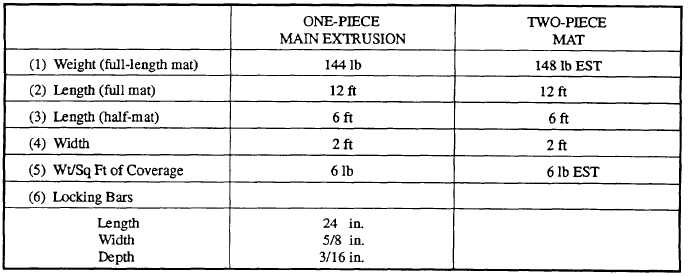The sides of the mat panels are constructed to interlock with a rotating motion. The end connectors are arranged with the prongs up on one end and down on the other (fig. 11-1, section A-A). By placing the end connector of one mat properly over the end connector of the previous mat, you can form a continuous layer of matting. A flat-locking bar is then inserted into the slot common to the two mats to form a nonseparable joint.
The physical characteristics of AM-2 matting are shown in table 11-1.
AM-2 mats are packaged in two standard pallet loads for storage and shipment. One pallet assembly, designated F11, consists of 11 full-length mats, 2 half-length mats, and 13 locking bars (fig. 11-2). The other mat pallet, designated F15, contains 16 full-length mats, 4 half-length mats, and 20 locking bars (fig. 11-3). The pallets are fabricated end frames that are held together by tie rods or strapping. The end frames fit around the ends of the mats and become the storage place for the locking bars.
The quantity of mats found in the standard pallet assembly (F11) provides a width of two rows (4 feet) on a runway or taxiway that is 72 feet wide. For widths other than 72 feet, more or less coverage (in terms of strip length) is obtained. Since the parking and storage areas need not have a specific mat pattern, as is required on the runways and taxiways, the "extra" half-length of full-length mats that result from the runway construction may be used in these areas. The use of a guide rail and/or keylocks will not affect the amount of coverage to any great extent.
INSTALLATION
As a Steelworker, you can be assigned to a project placing AM-2 mats for airfield surfaces; therefore, you need to be familiar with the procedures used for installing mats. Primary operations involving site preparation and pallet staging are also discussed. Additionally, information on manpower requirements and the organizational structure of the installation crew is presented.
Site Preparation
'he soil and subbase materials of the site selected as the SATS field must be suitable for use with the AM-2 landing mats. The subbase material must have a minimum compaction of 95 percent, and the engineering staff will provide you further guidance based on their analysis of the soil type and the available base materials.
The operations that are part of the site preparation that must be completed before mats are installed are as follows:
1. The terrain in the area to be used must be cleared, leveled, and rolled to provide the designated compaction for the matting base. Grading must provide adequate drainage of water away from the field area and the soil must be disturbed as little as possible in obtaining the prescribed finish. These operations will provide a soil having a maximum bearing capacity.
2. The soil in any area under the matting, requiring installation of service, drainpipes, or other objects, must be backfilled and thoroughly compacted
Table 11-1. - Physical Characteristics of AM-2 Matting

